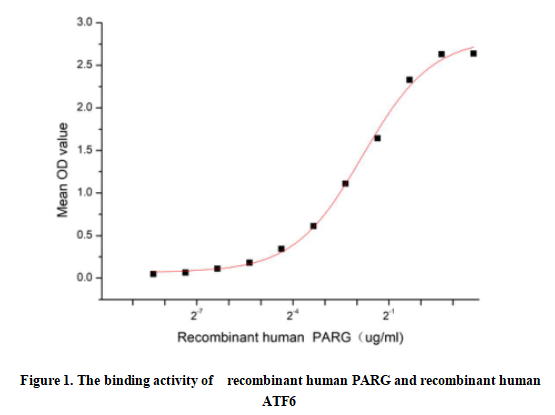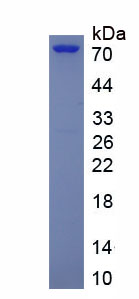Active Poly ADP Ribose Glycohydrolase (PARG) 

- UOM
- FOB US$ 302.00 US$ 755.00 US$ 1,510.00 US$ 4,530.00 US$ 11,325.00
- Quantity
Overview
Properties
- Product No.APP807Hu61
- Organism SpeciesHomo sapiens (Human) Same name, Different species.
- ApplicationsCell culture; Activity Assays.
Research use only - DownloadInstruction Manual
- CategoryEnzyme & Kinase
- Buffer FormulationPBS, pH7.4, containing 5% Trehalose.
- Traits Freeze-dried powder, Purity > 90%
- Isoelectric Point6.4
Sign into your account
Share a new citation as an author
Upload your experimental result
Review

Contact us
Please fill in the blank.
Activity test

Poly ADP Ribose Glycohydrolase (PARG) is a primary hydrolase involved in the degradation of poly(ADP-ribose) (PAR). It possesses both endo-glycohydrolase and exo-glycohydrolase activity, with a preference for the latter by binding to the two most distal ADP-ribose residues within the PAR chain. These enzymatic actions produce either free PAR or mono ADP-ribose moieties, respectively. The liberated mono ADP-ribose is further metabolized into AMP and ribose 5' phosphate by enzymes such as the NUDIX family. PARG thus plays a crucial role in regulating PAR levels, which are involved in various cellular processes including DNA damage response, chromatin maintenance, and DNA replication.Besides,Activating Transcription Factor 6 (ATF6) has been identified as an interactor of PARG, thus a functional binding ELISA assay was conducted to detect the interaction of recombinant human PARG and recombinant human ATF6. Briefly, biotin-linked PARG were diluted serially in PBS, with 0.01% BSA (pH 7.4). Duplicate samples of 100μl were then transferred to ATF6-coated microtiter wells and incubated for 1h at 37℃. Wells were washed with PBST 3 times and incubation with Streptavidin-HRP for 30min, then wells were aspirated and washed 5 times. With the addition of substrate solution, wells were incubated 15-25 minutes at 37℃. Finally, add 50µl stop solution to the wells and read at 450nm immediately. The binding activity of PARG and ATF6 was shown in Figure 1, the EC50 for this effect is 0.28ug/mL.
Usage
Reconstitute in 10mM PBS (pH7.4) to a concentration of 0.1-1.0 mg/mL. Do not vortex.
Storage
Avoid repeated freeze/thaw cycles. Store at 2-8°C for one month. Aliquot and store at -80°C for 12 months.
Stability
The thermal stability is described by the loss rate. The loss rate was determined by accelerated thermal degradation test, that is, incubate the protein at 37°C for 48h, and no obvious degradation and precipitation were observed. The loss rate is less than 5% within the expiration date under appropriate storage condition.
Increment services
-
 BCA Protein Quantification Kit
BCA Protein Quantification Kit
-
 Molecular Mass Marker for Protein
Molecular Mass Marker for Protein
-
 Monoclonal Antibody Customized Service
Monoclonal Antibody Customized Service
-
 Polyclonal Antibody Customized Service
Polyclonal Antibody Customized Service
-
 Protein Activity Test Experiment Service
Protein Activity Test Experiment Service
-
 Electrophoretic Mobility Shift Assay (EMSA) Experiment Service
Electrophoretic Mobility Shift Assay (EMSA) Experiment Service
-
 Buffer
Buffer
-
 Lentivirus Packaging Experiment Service
Lentivirus Packaging Experiment Service
-
 Adenovirus Packaging Experiment Service
Adenovirus Packaging Experiment Service
-
 Real Time PCR Experimental Service
Real Time PCR Experimental Service
-
 Spike RBD Protein (S-RBD)
Spike RBD Protein (S-RBD)
-
 Protein G
Protein G
-
 Protein A
Protein A







